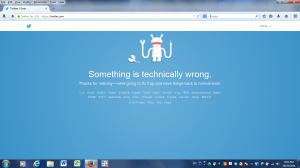Well, it is known as a formula for water. Not only.
H2O is also a tool and it is worth giving it a little more attention here. For this purpose I have interviewed Shailin Thomas (), a research associate at Harvard Law School.
Here is what I found out:
Q: What is H2O, why the name?
A: H2O is an online, Web-based platform for creating, customizing, and sharing course materials. H2O started as the brainchild of Professor Jonathan Zittrain over a decade ago, and has since evolved into an innovative tool used by professors at more than 14 universities. The materials on H2O are in the public domain, and the collections of course materials — known on the platform as “playlists” — are licensed through Creative Commons, allowing anyone to copy, edit, and repurpose a section of another professor’s course for her own pedagogical goals. The name H2O — and that’s literally an “O,” not a zero — is, to some extent, an artifact of history. H2O was christened at a time when 2.0 names were quite popular. Calling the platform H2O was meant to invoke the idea of an ocean of free and open materials from which professors could draw, while also giving a nod to the concept of Harvard 2.0.
Q: Who does H2O serve: a) by academic discipline (is it law only?); b) by geography
A: H2O is freely open and available for use by anyone anywhere — both for the consumption and creation of materials. It has received the most traction in law, in part because the subject matter of law school courses predominantly consists of public domain judicial opinions, but we are hoping to expand the platforms adoption to other disciplines as open-access resources proliferate.
Q: What problems does it solve?
A: Currently, professors are forced to tailor their courses to fit a small number of dominant textbooks on a given subject. In law, not only are they stuck with a particular set of cases in a given book, but they are also stuck with the edits made to those cases by the casebook authors. H2O allows professors to craft their own materials exactly the way they want them, without the restrictions imposed by the traditional textbook publishing market. Not only can they pick their own cases, but they can edit them to fit their own pedagogical objectives. In addition to the benefits for professors, H2O solves a number of problems for students. Students today are asked to pay $300 per course per semester for books that they have to lug around all day and of which they only read a small portion. H2O course materials are weightless, as they can be accessed from any internet-aware device, and they are completely, 100% free. Over the last few years, H2O has saved students hundreds of thousands of dollars in aggregated textbook costs.
Q: Are there competitors to this initiative/tool?
A: There are tools by which professors can send a PDF of their course materials to a service that will make them a course packet — often made available to students at a reduced price compared to a traditional casebook. But I am currently unaware of another platform that seeks to create a community of professors sharing and repurposing each other’s materials. Our hope is that, in the future, professors will be able to find a number of sample syllabi on the platform relevant to a course they would like to teach, giving them the opportunity to pull from those existing syllabi as they construct their own course.
Q: Are there institutions outside Harvard which adapted H2O?
A: While the code is open source, I know of no universities running their own instances of H2O. However, there are a number of faculty members at more than 14 universities across the country that are using the H2O platform in some capacity for their course materials.
Q: What trajectory do you see H2O moving (space, content, disciplines)
A: Our hope is that, as open-access models and materials proliferate, an increasing number of educational resources will become shareable in the ways that make their inclusion in H2O possible. Any resource on the Web can be linked to from an H2O syllabus, but the customized editing capabilities require that it be freely available in ways that traditional copyright prohibits. As more and more materials become available on H2O, we hope to incorporate many more types of content on the platform and expand to other academic disciplines.
